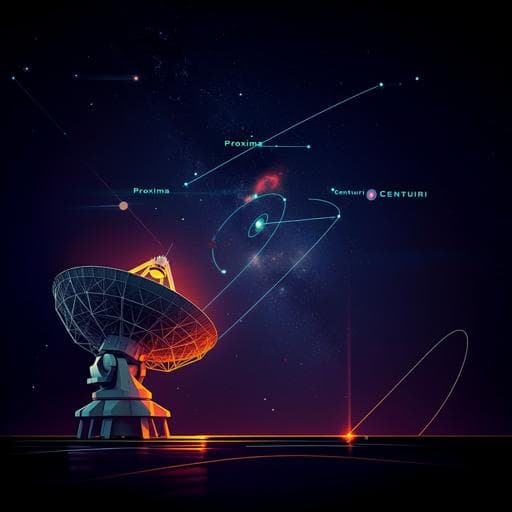
Space Sciences
Analysis of the Breakthrough Listen signal of interest blc1 with a technosignature verification framework
S. Z. Sheikh, S. Smith, et al.
Dive into the findings of the Breakthrough Listen SETI project as it delves into a narrowband signal detected near Proxima Centauri. This intriguing analysis uncovers that the detected signal, blc1, is not an extraterrestrial technosignature but rather a product of local interference. Join the authors in exploring the necessity for vigilant follow-ups in the search for signs of intelligent life beyond our planet.
~3 min • Beginner • English
Introduction
This study addresses how to verify potential technosignatures in radio SETI data and applies a general verification framework to the signal of interest 'blc1' detected near 982 MHz toward Proxima Centauri with the Parkes (Murriyang) telescope. Proxima Centauri is an attractive SETI target due to its proximity (1.295 pc), its exoplanet Proxima b in the traditional habitable zone, and interest from concepts such as Breakthrough Starshot. The research question is whether blc1 is an extraterrestrial technosignature or a form of terrestrial radio-frequency interference (RFI), and how a robust framework can discriminate between these possibilities. The initial blc1 characteristics that motivated deeper analysis were: it is a Hz-wide narrowband signal (indicative of technology), shows non-zero drift rates consistent with a non-terrestrial transmitter, exhibits approximately linear drift within each 30-minute observation panel with smooth evolution over hours, is absent in standard off-source pointings, and persists over several hours, unlike typical aircraft or satellite interferers. These properties prompted the development and application of a comprehensive verification workflow in the context of a complex RFI environment.
Literature Review
The work builds on prior Breakthrough Listen surveys and data systems, and on broader SETI practices that often rely on on/off-source cadence and re-observation to reject RFI. It references updates to the Rio scale for SETI detections and verification frameworks used in analogous fields (fast radio bursts, gravitational waves). The study situates blc1 within known RFI phenomena such as frequency combs and clock-oscillator-driven artifacts, and contrasts expected astronomical drift behaviors (e.g., barycentric corrections and planetary dynamics) with those of human-made emitters (ground-based, aerial, satellites, deep-space probes).
Methodology
- Observations: Used the CSIRO Parkes 'Murriyang' 64-m radio telescope with the Ultra-Wideband Low (UWL) receiver covering 0.704–4.032 GHz, during an international multi-wavelength Proxima Centauri flare monitoring campaign (project P1018). Breakthrough Listen (BL) performed a commensal technosignature search. Proxima Centauri was observed for a total of 26 h 9 min from 2019-04-29 to 2019-05-04.
- Data and search pipeline: Searched for narrowband drifting signals in high-resolution dynamic spectra with ~17 s subintegrations and ~4 Hz frequency resolution using turboSETI v1.2.2. The pipeline returned a single narrowband event ('blc1') appearing in two consecutive Proxima observations and absent in interleaved off-source observations upon visual inspection.
- Observing cadence and off-source choices: Non-standard cadence with 30 min integrations on ProxCen alternating with 5 min observations of bright calibrator quasars (and one pulsar), chosen for system temperature monitoring. Off-source calibrators PKS 1421-490 and PKS 1934-638 increased the effective noise floor (≈10 Jy sources; total flux density ≈48 Jy considering system equivalent flux density ~−38 Jy). Large angular separations (12.57° and 45.82° from ProxCen) led to long slews and potential temporal/spatial RFI mismatches.
- On/off verification: Examined all nine off-source waterfall panels around 982 MHz. Performed de-drifting of off-source panels to the nearest best-fit drift rates to search for attenuated counterparts. Also produced integrated (summed) spectra per panel and incoherent sums across off-source observations to search for faint persistent power.
- Frequency comb analysis: Computed auto-correlation in frequency to identify an RFI comb with ~80.1 Hz spacing across the 960–1087 MHz sub-band. Assessed presence across other UWL observations to test association with blc1.
- Drift characterization vs emitter classes: Modeled drift rates expected from telescope tracking alone, local ground/aerial routes and speeds, non-LEO satellites (GEO, MEO, others using space-track orbital elements), and deep-space probes (NASA Horizons). Compared observed drift morphology and persistence with these scenarios.
- Re-observations: Conducted follow-ups with the same receiver/backend and data products. In 2020-11-19/26/30, used a standard 15 min on / 15 min off cadence with nearby stellar off-sources; in 2021-04-29 to 2021-05-03, replicated original cadence and local time for 12 h per day. Searched for any signals at f_blc1 ± 2 kHz and any drift rates.
- Archival and contemporaneous searches near 982 MHz: Produced waterfall and 'butterfly' (drift-rate vs frequency power) plots for all ProxCen on/off observations from 2019-04-29 to 2019-05-04 in 982.002–982.004 MHz (±1 kHz as needed) to find blc1-like signals. Extended to ~7,000 archival Murriyang UWL observations (2019–2020) of nearby stars, pulsars, and quasars.
- Multi-frequency co-occurrence search: Computed frequency-normalized drift rates to find signals at other frequencies drifting proportionally to blc1 in the first panel. Queried turboSETI hit catalog for time-coincident hits and inspected morphology across subsequent panels.
- Harmonic and intermodulation analyses: Tested whether lookalikes could be explained by harmonic sequences from fundamentals in 100–1000 MHz range (1 kHz steps). Investigated intermodulation distortion by identifying families of 'triple feature' (TF) and 'single feature' (SF) lookalikes with spacings at integer multiples of common clock oscillators (e.g., 133.33 MHz, 15 MHz, 128 MHz). Predicted and searched for strong zero-drift interferers at central frequencies implied by mixing (e.g., 1200 MHz, 1400 MHz, ~1332 MHz). Quantified precise spacings consistent with a 2.000004 MHz clock oscillator (e.g., 16.000038 MHz) and evaluated error propagation given ~4 Hz channelization.
- Statistical comparison: Compared blc1 to the lookalike population in start frequency, normalized drift rate, and S/N via kernel density estimations and corner plots to test consistency.
- Interpretation framework: Assessed whether blc1 could be an intermodulation product generated by the interaction of external RFI with clock oscillators, considering BL receiver architecture (three ADC cards, RF-tight cabinets) and the distribution of lookalikes across the full band.
- Verification toolkit: Synthesized a 10-step checklist for technosignature verification (instrument checks, off-source searches, cataloged RFI checks, drift comparisons to human-made and astronomical expectations, searches for instances in archival data and other frequencies, assessment of common origin, RFI discrimination, and re-observation with same/other instruments).
Key Findings
- The signal of interest blc1 (near 982.0024–982.0028 MHz) is not an extraterrestrial technosignature but an electronically drifting intermodulation product of local, time-varying interferers aligned with the observing cadence.
- Table 1 parameters: Detection date 2019-04-29; first detection at 13:17:35.232 UTC, last at 18:19:26.400 UTC; persistence length 5.03 h; start frequency 982.0024 MHz, end 982.0028 MHz; initial drift rate 0.0326 Hz s⁻¹; average S/N 17.956 (across the five 30-min detections); bandwidth <3.81 Hz.
- Off-source analysis: No convincing detection of blc1 in eight off-source panels; a faint narrowband feature (S/N < 5) in the final off-source had 0 Hz s⁻¹ drift and was deemed inconclusive and likely unrelated given mismatch with expected drift and presence of a 0 Hz s⁻¹ comb.
- Frequency comb: Identified a non-drifting RFI comb with ~80.1 Hz spacing across 960–1087 MHz present in both on and off-source data, and seen in other UWL observations, implying it is unrelated to blc1.
- Emitter class exclusions: Drift characteristics and persistence are inconsistent with local ground/aerial sources and non-LEO satellites (including GEO). Deep-space probes’ positions and drifts do not match blc1.
- Re-observations: No signals detected at f_blc1 ± 2 kHz with any drift rate during re-observations on 2020-11-19/26/30 or during 2021-04-29 to 2021-05-03 (same cadence and local time as 2019).
- Additional instances near 982 MHz: Found four additional blc1-like signals during the ProxCen campaign (too faint to be flagged by turboSETI). Across ~7,000 archival UWL observations, found 15 similar features; 14 differ in morphology/length/drift/strength; one, seen four days before blc1, persisted across on/off and is clearly RFI.
- Multi-frequency lookalikes: Among time-coincident turboSETI hits drifting proportionally in the first panel, 111 RFI hits plus blc1 were retrieved; 36/111 (32%) are blc1 lookalikes with strikingly similar morphology; with negative drift search, 310 hits yielded 27 mirrored lookalikes (same drift structure, mirrored across frequency). All lookalikes and mirrored lookalikes appear in off-sources and are RFI.
- Population consistency: blc1 is consistent with the lookalike population in normalized drift rate, start frequency (slightly higher than the peak but compatible), and S/N.
- Harmonic/intermodulation evidence: Some lookalikes form harmonic/intermodulation families. TF set shows spacings at integer multiples of 133.33 MHz; SF set at multiples of 15 MHz with an additional 128 MHz. Predicted strong zero-drift interferers at 1400 MHz (found to within +4 Hz) and 1200 MHz (Hz-level match); for an 'x.y99' family, found strong signals at 1330.0000, 1331.2000, and 1332.1805 MHz near the predicted center (~1332 MHz).
- Clock oscillator linkage: Identified sequences with spacings consistent with a 2.000004 MHz clock oscillator (e.g., 16.000038 MHz = 8 × 2.000004 MHz; error propagation consistent with ±4 Hz channelization). The same spacings relate blc1 with lookalikes at ~712, ~856, and ~1062 MHz, indicating a common electronic origin via intermodulation.
- Interpretation: blc1 is too weak relative to strongest signals in the set and absent in off-panels unlike others, indicating it is not the primary source but an intermodulation product whose apparent localization results from duty-cycle/variability tracking the observing cadence. The intermodulation likely involves external RFI mixing with oscillators, not internally generated artifacts, as lookalikes span all ADC cards.
- Implications: Demonstrates how single-dish on/off cadence can, if matched to RFI duty cycles, mimic sky localization. Motivates robust multi-step verification and improved RFI characterization.
Discussion
The verification framework shows that blc1’s properties—narrowband, drifting, multi-hour persistence, and apparent absence in off-sources—can arise from complex RFI intermodulation aligned with the observing cadence, rather than extraterrestrial transmission. Comparative analyses of drift against plausible human-made emitters (ground, aerial, satellites, deep-space probes) and astronomical expectations, combined with non-detection in tailored re-observations, rule out an interstellar origin. The discovery of a sizable population of contemporaneous lookalikes and mirrored lookalikes with identical morphology and drift evolution, all demonstrably RFI, and their linkage by precise frequency spacings tied to common clock oscillators and strong zero-drift interferers at predicted central frequencies, provides a coherent explanation for blc1 as one member of an intermodulation product set. These findings address the research question by demonstrating a reproducible pathway from initial detection to RFI attribution and by codifying a generalizable 10-step technosignature verification checklist. The work highlights the need for detailed RFI environment understanding, broader-band context during validation, and, where possible, simultaneous multi-site or multi-beam observations to discriminate local from celestial signals.
Conclusion
This study concludes that the blc1 signal is an electronically drifting intermodulation product generated by mixing between strong zero-drift interferers and common clock oscillators, not an extraterrestrial technosignature. The principal contributions are: (1) development and application of a comprehensive, stepwise verification toolkit for narrowband technosignatures; (2) identification and characterization of a population of blc1-like RFI signals and their mirrored counterparts; (3) harmonic/intermodulation analyses that link these signals via precise oscillator-driven spacings and predicted central interferers; and (4) demonstration that single-dish on/off cadence can be pathologically fooled by cadence-matched RFI duty cycles. Future work should include simultaneous multi-site observations (e.g., MeerKAT and Murriyang), deeper hardware characterization (e.g., cold-load tests to probe aliasing and mixing paths), noise-injection testing of lookalike populations, recording during slews to assess sidelobe localization, omnidirectional high-resolution RFI surveys on site, and software/pipeline enhancements (e.g., broader-band context retention, real-time triage of voltage products) to accelerate robust validation.
Limitations
- The RFI environment at the required narrow frequency resolution is not fully characterized; mixing products obscure the identities and exact frequencies of the original interferers. The study focuses on establishing terrestrial origin rather than fully deconvolving the signal chain responsible.
- The non-standard cadence and use of bright calibrator off-sources increased noise floors and introduced asymmetries in S/N between on/off-source panels, complicating direct comparisons.
- The presence of a strong 0 Hz s⁻¹ frequency comb in the band complicates parameter estimation (e.g., S/N) and interpretation, even though it is deemed unrelated to blc1.
- While evidence strongly supports an intermodulation origin and identifies likely oscillator frequencies and central interferers, the precise hardware path (internal vs external mixing points) is not definitively reconstructed.
Related Publications
Explore these studies to deepen your understanding of the subject.







